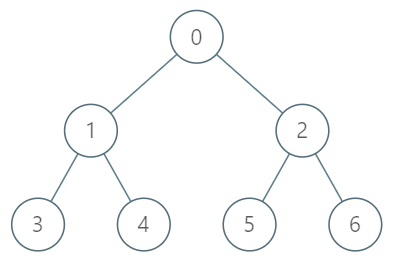题目描述
给你一棵树,树上有 n 个节点,按从 0 到 n-1 编号。树以父节点数组的形式给出,其中 parent[i] 是节点 i 的父节点。树的根节点是编号为 0 的节点。
请你设计并实现 getKthAncestor(int node, int k) 函数,函数返回节点 node 的第 k 个祖先节点。如果不存在这样的祖先节点,返回 -1 。
树节点的第 k 个祖先节点是从该节点到根节点路径上的第 k 个节点。
样例

输入:
["TreeAncestor","getKthAncestor","getKthAncestor","getKthAncestor"]
[[7,[-1,0,0,1,1,2,2]],[3,1],[5,2],[6,3]]
输出:
[null,1,0,-1]
解释:
TreeAncestor treeAncestor = new TreeAncestor(7, [-1, 0, 0, 1, 1, 2, 2]);
treeAncestor.getKthAncestor(3, 1); // 返回 1 ,它是 3 的父节点
treeAncestor.getKthAncestor(5, 2); // 返回 0 ,它是 5 的祖父节点
treeAncestor.getKthAncestor(6, 3); // 返回 -1 因为不存在满足要求的祖先节点
限制
- $1 \leq k \leq n \leq 5*10^4$
- $parent[0] = -1 表示编号为 0 的节点是根节点。$
- $对于所有的 0 < i < n ,0 \leq parent[i] < n 总成立$
- $0 \leq node < n$
- $至多查询 5*10^4 次$
算法
(倍增) $O(mlog(n))$
- 设$f[i][j]$表示从点$i$向上跳$2^j$次能到达的点
- 状态转移:先向上跳$2^{j-1}$次,再从该位置向上跳$2^{j-1}$次
$f[i][j] = f[f[i][j - 1]][j - 1]$ - 最坏情况下是一个长度为$5*10^4$的链表,因此$f$的第二个维度设为16足够
- 初始时,从根节点向下用$BFS$预处理出$f$的值
时间复杂度
- 初始化时,宽搜每个节点都会被枚举到,并且更新$f$的状态,时间复杂度为$O(n * 16)$
- 查询时,设查询$m$次,每次查询复杂度为$O(log(n))$,因此总时间复杂度为$O(mlog(n))$
C++ 代码
class TreeAncestor {
public:
vector<vector<int>> f, g;
int root;
TreeAncestor(int n, vector<int>& p) {
f = vector<vector<int>>(n, vector<int>(16, -1));
g = vector<vector<int>>(n);
for (int i = 0; i < p.size(); i ++ )
if (p[i] == -1) root = i;
else g[p[i]].push_back(i);
queue<int> q; q.push(root);
while (q.size()) {
int t = q.front(); q.pop();
for (auto c : g[t]) {
q.push(c);
f[c][0] = t;
for (int k = 1; k < 16; k ++ )
if (f[c][k - 1] != -1)
f[c][k] = f[f[c][k - 1]][k - 1];
}
}
}
int getKthAncestor(int node, int k) {
for (int i = 16; i >= 0; i -- )
if (k >> i & 1) {
node = f[node][i];
if (node == -1) return -1;
}
return node;
}
};
/**
* Your TreeAncestor object will be instantiated and called as such:
* TreeAncestor* obj = new TreeAncestor(n, parent);
* int param_1 = obj->getKthAncestor(node,k);
*/

